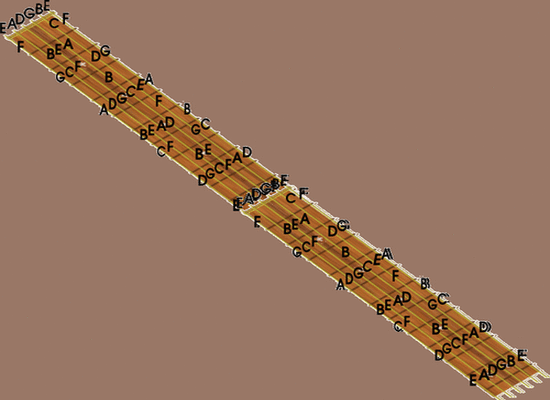FRETBOARD PATTERNS
|
There is no easy way to learn the notes on the fretboard. You should begin by memorizing the names of each open string. From there the 12th fret is the same as the open string, just an octave higher. You should learn to tune your guitar and memorize those notes. From there you can look for patterns for memorizing the fretboard, of just finding your way around. As far as finding the notes or intervals of a scale in a certain key, you can stay with one string and the pattern will be the same for every string. | ||||||||||||
|
The name of the string is the name of the key for that scale. Also the names of the notes in that key. for the Keys of C and F you should begin with those notes on each string. | ||||||||||||
|
After looking at the fretboard for a while you may see patterns. Here is one that is true for all notes on the fretboard. This shows the note E on the fretboard. Look at their distance from each other, and all other notes will be the same distances from each other. There are some general rules: Reading up the fretboard from the open E string (1st), you will find the same note 5 frets down on the adjacent string (2nd). The pattern changes when going from the 2nd string to the 3rd, count is 4 frets. Then it is back to 5 frets for all other strings, 3rd to 4th, 4th to 5th and 5th to 6th. The second pattern is in the opposite direction. Reading down the fretboard from the 12th fret on the 1st string, you will find the same note counting 7 frets up the adjacent string. This is true for all strings again except for when going from the 2nd to the 3rd string, then it is 8 frets away. It is a little easier if you do some simple math in your head. There are 12 intervals in a scale. 7+5=12, and 8+4=12. If I am on the 12th fret of the 1st string and subtract 7 from 12, then the note will be on the 5th fret of the 2nd string. You can study this pattern easier with a longer fretboard...as if it is going into infinity. The pattern remains the same. | ||||||||||||
 In brief, whatever note you are on, you'll find the same note on the adjacent string as follows: From 1st string to the 6th string, it is -7 toward the open string or +5 towart the 12th fret. Except for 2nd and 3rd string, then it is -8 toward the open, and +4 toward the 12th fret. Reversing the process, moving from the 6th string to the 1st, it is -5 goung toward the open strings and +7 going toward the 12th string, with the exception of moving from the 3rd to the 2nd string, then it is -4 toward the open and +8 toward the 12th. | ||||||||||||
The above pattern asked "Where is that note?". The pattern below asks, "What note is that?". This pattern requires that you memorize the first and sixth strings (E strings) which are the same, just an octave higher or lower. This string is usually the one you become most familiar with in the usual course of studying guitar. It is a string that barre chords are based on. The root note of the chord, being on the 6th string. This pattern can be useful for writing chords or music. It is a way of finding all the notes on a particular fret by adding or substracting from the location of the note on the first string. It too holds true for all frets. This image shows the pattern as based on the B note, 7th fret of the 1st string. | ||||||||||||
| The pattern shows: Same fret, 2nd string = fret-5 (=2=F#) Same fret, 3rd string = fret+3 (=10=D) Same fret, 4th string = fret-2 (=5=A) Same fret, 5th string = fret+5 (=12=E) | ||||||||||||
| Again you can reverse the pattern by starting with the 6th string and moving toward 5, 4, 3, 2, and reversing the pattern, +5, -2, +3, -5 | ||||||||||||
|